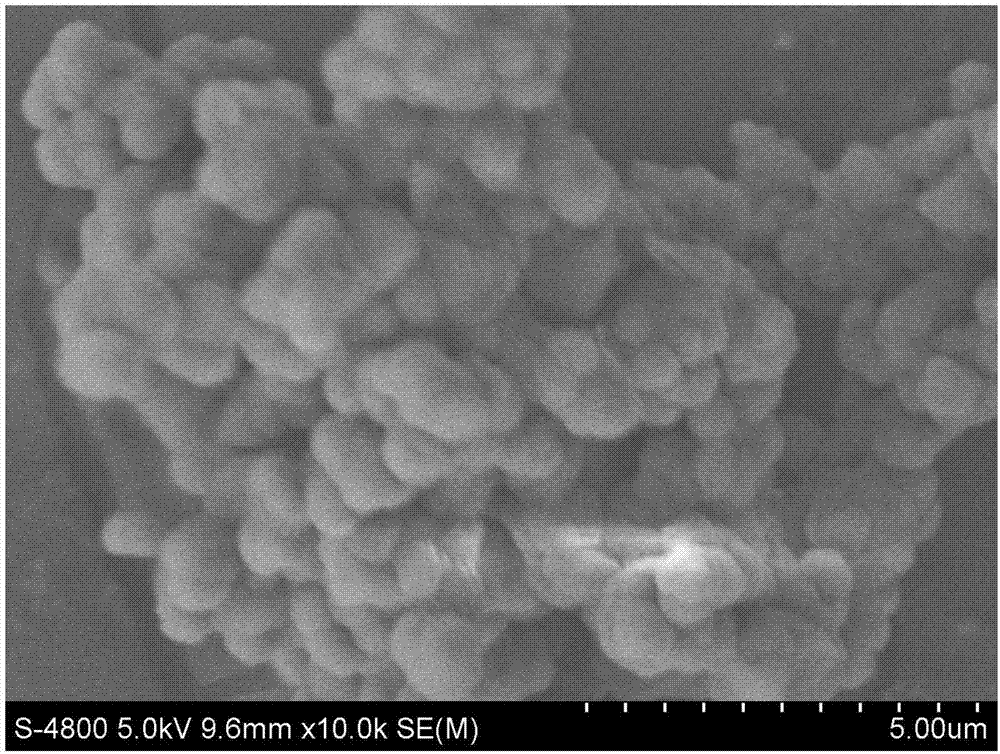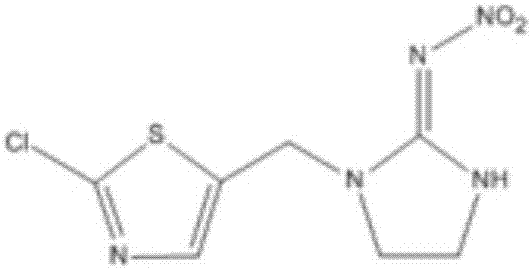Preparation method and application of imidaclothiz MIP (molecularly imprinted polymer) microspheres
A technology of molecular imprinting and chlorothialine, which is applied in the preparation of microspheres, microcapsule preparations, chemical instruments and methods, etc., can solve the problems of limited enrichment times, false positives, high cost, etc., and achieve strong molecular recognition capabilities and improve Adsorptive, high selectivity effect
- Summary
- Abstract
- Description
- Claims
- Application Information
AI Technical Summary
Problems solved by technology
Method used
Image
Examples
Embodiment 1
[0026] This embodiment provides a method for preparing chlorothialine molecularly imprinted polymer microspheres, which at least includes the following steps:
[0027] In the first step, α-methacrylic acid and chlorothialine are dissolved in the solvent acetonitrile at a molar ratio of 7:1. The volume ratio of the amount of chlorothialine to the solvent is 1mmol:80mL, and then the crosslinking is added. Ethylene glycol dimethacrylate, the molar ratio of crosslinking agent to chlorothialine is 45:1, then ultrasonic 5min under the condition of power of 65W, filled with nitrogen for deoxygenation, sealed, preheated at 0-4℃ After polymerization for 12 hours, transfer the prepolymer to a polypropylene plastic cylindrical polymerization reactor, add column chromatography silica gel and initiator, the sum of the amount of α-methacrylic acid and crosslinking agent and the initiator azo The mass ratio of diisobutyronitrile is 130mmol:1g, the mass ratio of column chromatography silica gel ...
Embodiment 2
[0032] This embodiment provides a method for preparing chlorothialine molecularly imprinted polymer microspheres, which at least includes the following steps:
[0033] In the first step, α-methacrylic acid and chlorothialine are dissolved in the solvent acetonitrile at a molar ratio of 9:1. The volume ratio of the amount of chlorothialine to the solvent is 1mmol:70mL, and then the crosslinking is added. Ethylene glycol dimethacrylate, the molar ratio of cross-linking agent to chlorothialine is 55:1, then ultrasonic 3min under the condition of power of 70W, filled with nitrogen for deoxygenation, sealed, preheated at 0-4℃ Polymerize for 18 hours, then transfer the prepolymer to a polypropylene plastic cylindrical polymerization reactor, add column chromatography silica gel and initiator, the sum of the amount of α-methacrylic acid and crosslinking agent and the initiator azo The mass ratio of diisobutyronitrile is 150mmol:1g, the mass ratio of column chromatography silica gel to c...
Embodiment 3
[0037] This embodiment provides a method for preparing chlorothialine molecularly imprinted polymer microspheres, which at least includes the following steps:
[0038] The first step is to dissolve α-methacrylic acid and chlorothialine in the solvent acetonitrile at a molar ratio of 6:1, where the volume ratio of the amount of chlorothialine to the solvent is 1mmol:90mL, and then add the crosslinking Ethylene glycol dimethacrylate, the molar ratio of crosslinking agent to chlorothialine is 58:1, then ultrasonic 4min under the condition of power of 75W, filled with nitrogen to remove oxygen, sealed, preheated at 0-4℃ Polymerize for 10 hours, then transfer the prepolymer to a polypropylene plastic cylindrical polymerization reactor, add column chromatography silica gel and initiator, the sum of the amount of α-methacrylic acid and crosslinker and the initiator azo The mass ratio of diisobutyronitrile is 180mmol:1g, the mass ratio of column chromatography silica gel to chlorothialin...
PUM
 Login to View More
Login to View More Abstract
Description
Claims
Application Information
 Login to View More
Login to View More - R&D
- Intellectual Property
- Life Sciences
- Materials
- Tech Scout
- Unparalleled Data Quality
- Higher Quality Content
- 60% Fewer Hallucinations
Browse by: Latest US Patents, China's latest patents, Technical Efficacy Thesaurus, Application Domain, Technology Topic, Popular Technical Reports.
© 2025 PatSnap. All rights reserved.Legal|Privacy policy|Modern Slavery Act Transparency Statement|Sitemap|About US| Contact US: help@patsnap.com



